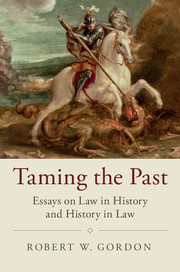Book contents
- Taming the Past
- Studies in Legal History
- Taming the Past
- Copyright page
- Dedication
- Contents
- Foreword
- Permissions
- Introduction
- Part I The Common Law Tradition in Legal Historiography
- Part II Legal Historians
- Part III History and Historicism in Legal History and Argument
- 10 Historicism in Legal Scholarship*
- 11 Critical Legal Histories*
- 12 The Past as Authority and as Social Critic: Stabilizing and Destabilizing Functions of History in Legal Argument*
- 13 Taming the Past: Histories of Liberal Society in American Legal Thought*
- 14 Originalism and Nostalgic Traditionalism
- 15 Undoing Historical Injustice*
- Index
11 - Critical Legal Histories*
from Part III - History and Historicism in Legal History and Argument
Published online by Cambridge University Press: 13 July 2017
- Taming the Past
- Studies in Legal History
- Taming the Past
- Copyright page
- Dedication
- Contents
- Foreword
- Permissions
- Introduction
- Part I The Common Law Tradition in Legal Historiography
- Part II Legal Historians
- Part III History and Historicism in Legal History and Argument
- 10 Historicism in Legal Scholarship*
- 11 Critical Legal Histories*
- 12 The Past as Authority and as Social Critic: Stabilizing and Destabilizing Functions of History in Legal Argument*
- 13 Taming the Past: Histories of Liberal Society in American Legal Thought*
- 14 Originalism and Nostalgic Traditionalism
- 15 Undoing Historical Injustice*
- Index
Summary
[This essay was published in 36 Stanford Law Review 57 (1984), as part of the Review’s special Symposium issue on Critical Legal Studies (CLS), a movement of left-leaning intellectuals who were just then coming to prominence in the legal academy. The Symposium included the work of many members of the movement as well as of some of their critics.
Since much of what CLS stood for has been forgotten (or badly distorted in the remembering), a brief summary of some of its aims and methods may be useful. It was never a unified thing; its views were as diverse as its members; but there was common agreement around the idea that the way law was taught in American law schools, rationalized in legal scholarship, and deployed in legal arguments and decision-making, all tended to contribute to the complacent idea that the legal system in force was just about as efficient, just, and rational a system as it could be (“false legitimation” we called this); and that it could not be reformed except in minor ways without risking economic and political catastrophe (“false necessity”). The motto of the legal system might have been Margaret Thatcher’s “There is no alternative.” CLS writers launched a volley of critiques of this tragic-complacent set of assumptions, designed to show that there were indeed alternatives, many of which were already embedded in the legal system itself, often as exceptions to prevailing dominant rules and doctrines. Many of the CLS critiques revived and extended the work of Legal Realists of the 1920s and 30s. The critiques began by trying to expose and challenge the implicit political economy of the first year law curriculum, then expanded to critique the emerging theories of the new law-and-economics movement, and eventually law as it was being applied in areas of policy, such as housing, welfare, labor law, corporate law, legal ethics, consumer protection, and many others. CLS went into eclipse in the 1990s, as the limited space for leftist views in the legal academy was increasingly taken up by critical race, feminist, and gay-and-lesbian studies. But many of its insights have been absorbed into mainstream legal scholarship.
This piece (which turns out to have been the most frequently cited of my essays on legal historiography) was partly written to describe a distinctive mode of legal history being written by scholars affiliated with CLS. But it also had a broader aim, that of trying to tease out and make explicit a set of background assumptions (here called “evolutionary functionalism”) about the course of Western history, and of the relation of law to that history and to society generally, that American legal scholars tended to take for granted; and to question those assumptions. In 2012 the journal Law & Social Inquiry invited several legal historians (Hendrik Hartog, Susanna Blumenthal, Laura Edwards, and Christopher Tomlins) to revisit the essay: their comments, and my response, are in 37 Law & Social Inquiry 147–215 (2012). Tomlins has also written an extremely provocative analysis of the program of “critical historicism” described in this and other essays in this volume, recognizing its strengths as critique but deploring its erosion of causal explanation; and proposing ways to retheorize law–society relations: Tomlins, “After Critical Legal History: Scope, Scale, Structure, 8 Ann. Rev. Law & Soc. Sci (2012): SSRN:http://ssrn.com/abstract=2034423.]
- Type
- Chapter
- Information
- Taming the PastEssays on Law in History and History in Law, pp. 220 - 281Publisher: Cambridge University PressPrint publication year: 2017

